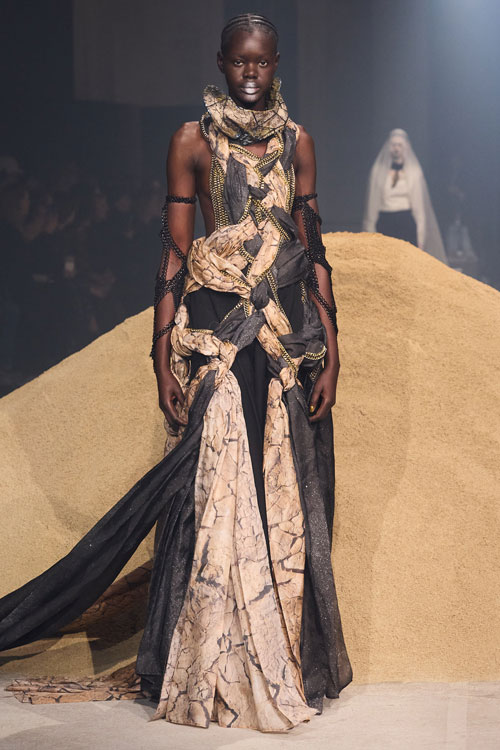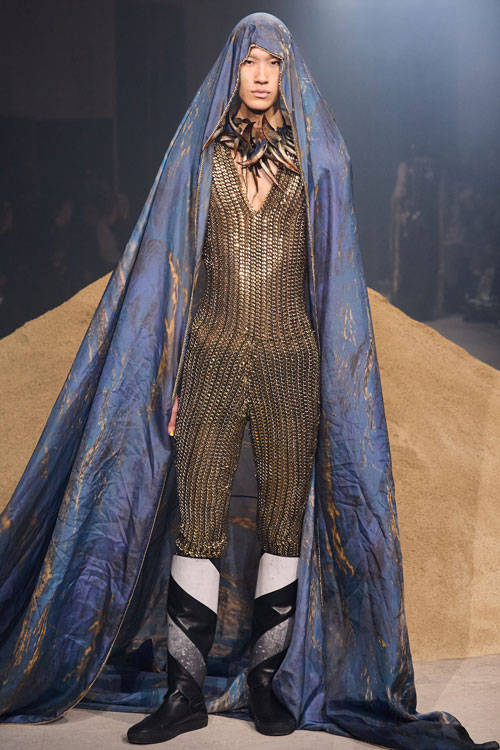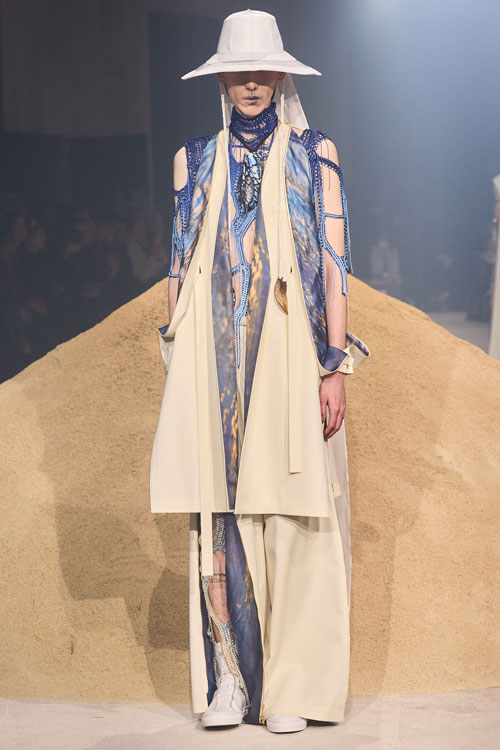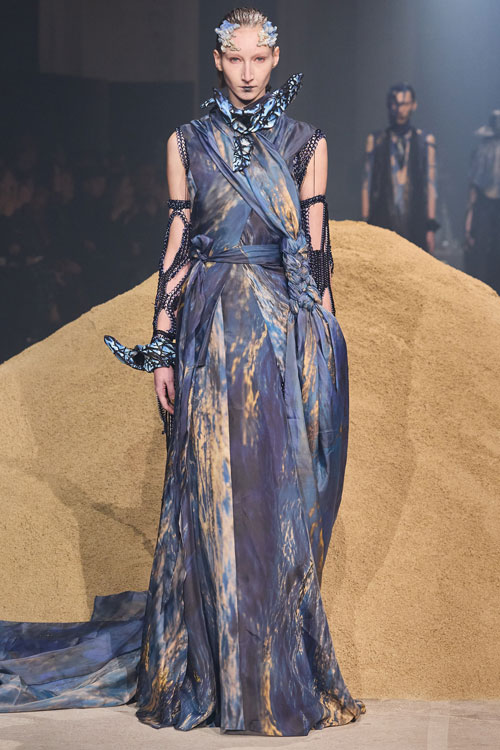The future of fashion co-created with YUIMA NAKAZATO

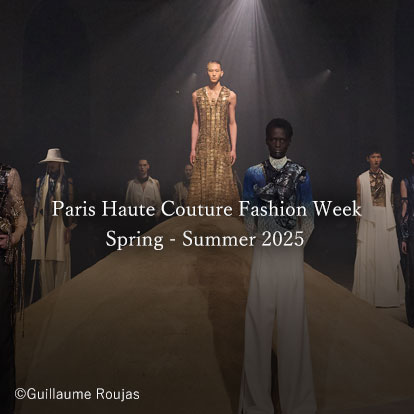
On January 29, 2025, Epson supported the creation of YUIMA NAKAZATO's latest collection "FADE", unveiled at Paris Spring - Summer Haute Couture Week 2025.
Mr. Nakazato, who visits various places around the world alongside his creative activities, drew inspiration for this collection from his journey to the Sahara el Beyda, a white desert in a corner of the east Sahara, which was once the bottom of the sea. The beautiful scenes of the sky transitioning from day to night and the landscape encountered during his travels were captured by Mr. Nakazato himself and used in the print designs of the costumes. Additionally, in the research of non-woven fabric sheets made from mill ends and used garments, some of these were used in sneakers and hats showcased on the runway, marking the first commercialization by YUIMA NAKAZATO.
Digital printing has become a necessary technology for his collections
Mr. Nakazato thought that by using his own landscape photographs directly in his designs, people wearing the clothes could also relive the memories of that journey. In this collection, he designed the garments while envisioning how the printed fabric will look once transformed into clothing.
For example, when printing on sheer silk organdy fabric, the fabric is carefully selected to ensure an optimal thickness, one that prevents ink from bleeding yet still provides the desired coloration.
AI-generated imaging technology is incorporated into the creation of print image data. This allows for the natural duplication and arrangement of photographic images in a randomized manner, efficiently adapting the print to fit the fabric width.
Mr Nakazato has further refined his approach by working with digital printing techniques, driving evolution in processes such as fabric selection and data creation.
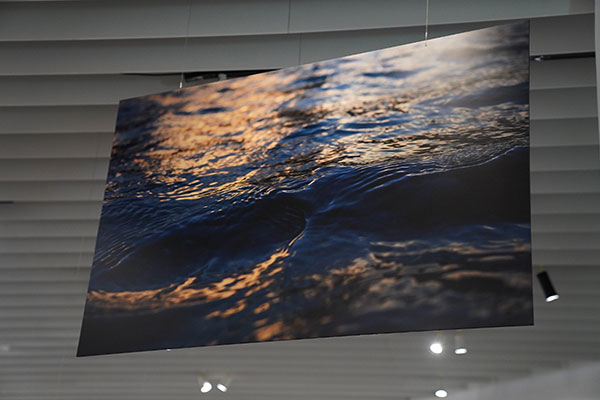
YUIMA NAKAZATO commercialized the first sneakers to be made using non-woven fabric
Mr. Nakazato has deepened his understanding of the characteristics of non-woven fabric sheets with each season, and through trial and error in design, he has explored which items made from the sheets are suitable for fashion. As a result, he arrived at the idea of creating and commercializing YUIMA NAKAZATO's first sneakers, boots, and hats to incorporate non-woven fabric.
Particular attention was paid to Epson's Dry Fiber Technology1, which involves layering cotton (in its fibrous form) to create sheet-like material. This technique allows for the creation of a gradient on the sheet's surface. Digital printing techniques were then applied to furthr enhance the depth of the gradient. The uniqueness of each sheet’s appearance, varying slightly from piece to piece, pairs well with haute couture, which aims to offer one-of-a-kind creations, as Mr. Nakazato explains.
Mr. Nakazato said, "Actually, the non-woven fabric on this sneaker wraps around the outside of the shoe in a swirling pattern, the color gradually changing from black to white. It’s like a Japanese ink painting or a representation of washi paper. It’s a material that’s never been seen before."
This sneaker was sold in limited quantities by YUIMA NAKAZATO at the YUIMA NAKAZATO Exhibition, which opened on February 3, 2025.
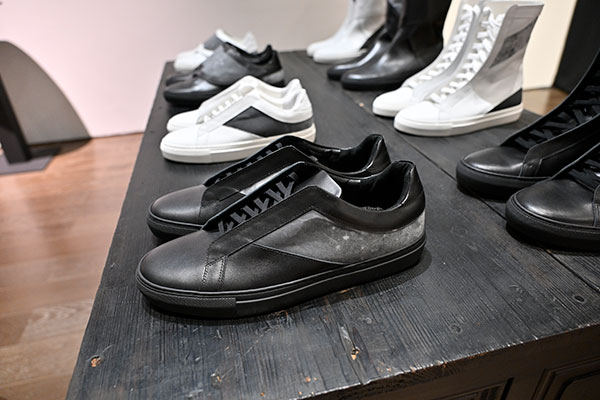
YUIMA NAKAZATO Exhibition, a legacy of a three-year partnership
YUIMA NAKAZATO and Epson have been working together to evolve sustainable fashion. The outcome of this collaboration was showcased for the first time in Japan at the YUIMA NAKAZATO Exhibition, a a solo exhibition by designer Mr. Yuima Nakazato. Epson sponsored the exhibition, which was held from February 3 to 16, 2025, at Tokyo City View
In addition to the latest collection that Mr. Nakazato had just unveiled in Paris, clothing from past collections, "UTAKATA" and "UNVEIL," were also displayed. The exhibition featured sketches by Mr. Nakazato, which are usually not seen in regular collection presentations, as well as photographs from his travels that inspired his designs. There were also fragments showcasing the exploration process behind the creation of the DFT sneakers.
Various Epson technologies that supported the exhibition were showcased. Epson's inkjet printers were used in the exhibition’s decorations, such as display panels featuring runway photos from past collections. Some of the exhibition posters were made using DFT to attempt paper recycling. Part of the raw material used was scrap paper created by Mr. Nakazato for the decorations at the Paris collection venue, which was then recycled for the posters. This resulted in a unique texture unlike regular paper. Additionally, the pamphlets for visitors were printed on recycled paper produced using Epson’s PaperLab A-81002, a dry office paper recycler.
This was a rare opportunity to experience works usually only seen during Paris Haute Couture Week and to touch on the inspirations behind Mr. Nakazato’s creations. It was also a precious opportunity to share the long-standing efforts of Mr. Nakazato and Epson with visitors.


1 Proprietary Epson technology for defibrating a wide variety of materials for functional, high-performance applications with very little water. For details, please click on the link to the Dry Fiber Technology website. Dry Fiber Technology
2 For more information about PaperLab, please click on the link here. PaperLab



